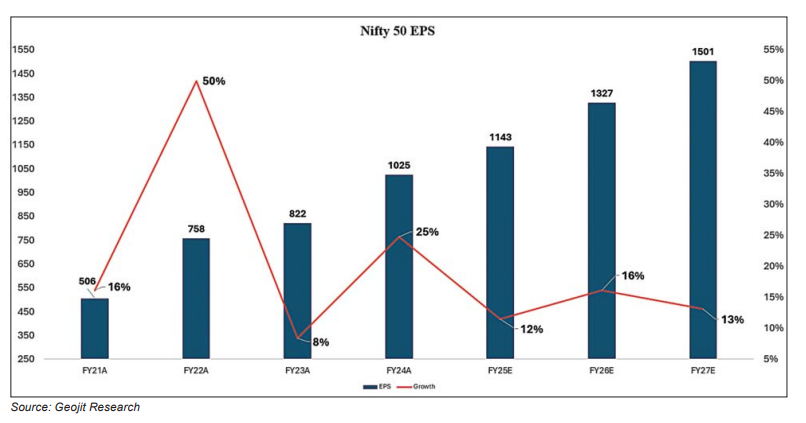Since late September, the Indian stock market has been experiencing a correction, primarily due to persistent global economic pressures, including high inflation and emerging geopolitical risks. Ongoing tensions in the Middle East have not significantly impacted crude oil prices. However, India’s earnings growth slowdown and its inflated domestic valuations have caused it to lag its Asian peers. As a result, India now faces the potential narrowing of its premium valuations over other EMs, a position it has held since May 2021. A shift in sentiment among global investors is evident, with the prevailing theme being “Sell in India, Buy in China”. Investors are increasingly attracted to the Chinese market, lured by its attractive low valuations and recent stimulus measures designed to spur growth. Moreover FII outflows from India have intensified and may continue if China’s stimulus efforts successfully revive its economy.
Domestically, the RBI’s October policy took a neutral stance, though the shift from ‘withdrawal of accommodation’ to ‘neutral’ is considered a long-term positive. Bank stocks are struggling to hold their ground in anticipation of an increase in NPAs and postponement in the reduction of domestic interest rates. The increase in monthly CPI and the upward revision of the RBI’s inflation target for Q3 FY25 confirm that rate cuts are unlikely in the near future, barring significant reductions by the US FED. Further, the volatility in input prices and the impact on margin are weighing on corporate earnings. The outcome of the ongoing corporate Q2 results is crucial going forward, with the current subdued outlook expected to put short-term pressure on the domestic stock market.
Subdued earnings outlook
The Q2 previews indicate a weak outlook, though it is expected to be slightly better than the subdued performance in Q1. Nifty50 index PAT is expected to grow by 8-10% YoY compared to 7% in Q1. However, the recovery is subdued across the economy, with extreme weakness in sectors like Oil & Gas, FMCG, Cement, and Banks. Positive momentum is seen in a few sectors such as Telecom, Metals and Power. The main reasons for the low increase in profitability or QoQ improvement are a lack of enhancement in global demand, a reduction in domestic demand like government and rural spending, and high inflation. Elevated global and rural inflation and reduction in realisations are affecting sales and margins. QoQ improvement in PAT is only 4%, much below the earlier view.
Over the past two to three years, India has significantly benefited from an expansion in operating margins, which contributed to a 25% earnings growth in FY24. However, margins are now either flat or contracting, dampening growth prospects. Early signs from Q2 results suggest a challenging outlook for corporate earnings in the short term. With both Q1 and Q2 underperforming, doubts are emerging about whether the anticipated recovery in Q3 and Q4 will materialize as expected by the market.
If the risk of earnings downgrades, as seen in Q1, continues to rise, it could lead to a reduction in India’s premium valuations. India has enjoyed elevated premium valuations over the past 3-4 years, but this advantage could diminish, creating caution in the market in the near term. Earnings growth is expected to drastically reduce from 25% in FY24 to 12% in FY25 and can recover to 16% in FY26. The risk of further downgrade persists. Cut in future valuation and weak performance of the broad market in the short-term are possible.

India is underperforming compared to peers
The FED’s unexpected 50bps rate cut in September has boosted emerging markets, as investors anticipate increased FII inflows. This could lead to a possibility of dollar depreciation and EM currency appreciation as the US interest rates decline. Typically, this reallocation of funds to emerging markets is driven by the urge to look for growth outside the US and the forecast of a slowdown of the economy. Currently, this trend is further supported by the relatively high valuations of dollar-denominated markets compared to those in emerging economies. In this context, India, as an emerging market, is currently underperforming relative to its peers. This is partly due to India being on a weak footing, as the domestic stock market has already been trading at high valuation and exhibits subdued dynamics in the light of a slowdown in corporate earnings. The underperformance intensified as investors shifted funds to Asian counterparts like China, which is trading at significantly lower 1 year forward P/E in dollar terms of 10x to 25x of India’s premium valuation.
Rising tensions in West Asia have had an outsized impact on the Indian stock market compared to the broader global context. While other countries are managing these tensions more effectively, India’s dependence on crude oil imports means that fluctuations in oil prices directly influence its trade deficit. Currently, the Middle East geo-political risk is not affecting the crude prices, which are comfortably trading below $75. This is because the global economy is slowing, reducing demand for crude while supply is increasing from non-OPEC, reducing the effect on oil prices. However, we maintain our view that India is likely to underperform other EMs in the short term, with midcap stocks expected to lag domestic large caps.
Expect change in texture, outperformance of mid and small caps is narrowing
The market depth is narrowing which is in contrast of the last 5 years. Nifty 100 was up by 116%, while Midcap 100 and Smallcap 100 were up 250%, and 223%, respectively in the last 5 years. Where mid and small caps on average outperformed large caps by two times. In the last one-year Nifty100 is up by 32%, while mid and small caps are up by 46% and 47%, respectively, narrowing the outperformance. The trend over the past three months has been somewhat different, with returns for the three categories remaining flat. This suggests that large-cap stocks are better positioned to weather market downturns. We can expect this change in trend to sustain.
Mid and small caps are likely to underperform large caps and India’s underperformance to other emerging markets may continue in the short to medium-term. It is because these categories and India have been trading at a premium valuation to EMs for a long period. Midcaps’ premium stands at historic peak of 55%. Also, large caps are better placed to handle global slowdown as indicated by the FED’s accommodative stands in September policy meet. Despite overall market caution, investor sentiment continues to be buoyant on the broad market. It is looking at opportunity on a stock-to-stock basis to capitalise from the recent correction and ongoing consolidation.
At the same time, investors are also reassessing their portfolio as concern is arising that equity assets will have to bear the weakness due to a slowdown in the economy and tightening of financial liquidity. Promising sectors are consumption, FMCG, infrastructure, newgeneration stocks, manufacturing, and chemicals. Conversely, sectors like capital goods, real estate, IT, pharmaceuticals, and autos may be at a greater risk of underperforming in the short to medium term.







